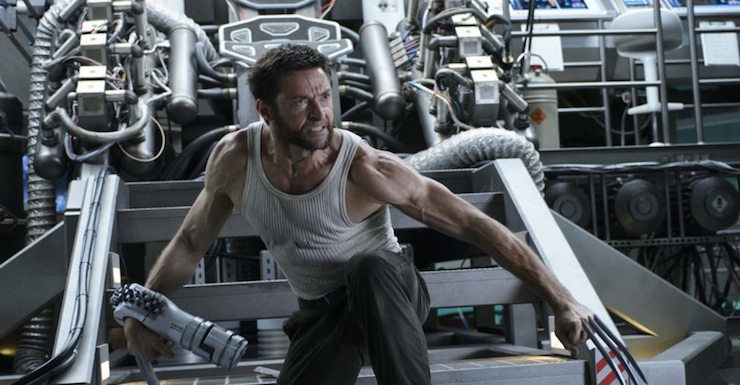In the late 1970s, DC experimented with the notion of a limited series: a comics series that wasn’t an ongoing monthly or bimonthly, but had a set number of issues (usually four or six). The notion proved successful, and it wasn’t long before Marvel did the same, using the shorter-form to spotlight characters who might not have been able to support an ongoing (or who they wanted to test the possibility of an ongoing), or to tell a story that wouldn’t work in any particular monthly book. Now, of course, limited series are the most common form of comics storytelling, but it was brand new and very experimental forty years ago.
One of the first ones Marvel did was to team up two of their hottest talents—Uncanny X-Men writer Chris Claremont with the guy who revived Daredevil, Frank Miller—on the most popular member of the X-Men, Wolverine. This was in 1982, and the four-issue miniseries in question proved to be hugely successful. It remained one of the definitive Wolverine stories, one that has been riffed on, copied, and satirized hundreds of times since—up to and including being the basis of the 2013 movie The Wolverine.
Wolverine’s affinity for Japan was established when the X-Men traveled there following a fight against Magneto in the Antarctic and a trip to the Savage Land. This was one of the “You never told us”/”You never asked” revelations, as they arrive to discover that Logan speaks and reads Japanese. He also meets Mariko Yashida, and they fall in love. The 1982 miniseries ended with their engagement, though the wedding wound up being cancelled due to Mariko being manipulated by Mastermind. Eventually, Mariko died by Logan’s hand at her request after a rival poisoned her.
In the comics, Logan’s backstory includes plenty of trips to Japan, which is where he learned the language. The 1984 miniseries Kitty Pryde & Wolverine revealed that one of Logan’s mentors was a demon ninja named Ogun.
Following the financial (if not critical) success of X-Men Origins: Wolverine, Fox green-lit another movie starring the immensely popular Jackman. From the beginning, the intent was to go to Japan and adapt that 1982 miniseries in some form or other, which Jackman has stated is his favorite Wolverine story. Originally, Darren Aronofsky—who had worked with Jackman on The Fountain—was to direct and Christopher McQuarrie was to write. Several issues delayed the production: Jackman was in a production of Les Misérables, Aronofsky couldn’t make the lengthy shooting schedule in Japan work for him and his family and so had to be replaced, and then an earthquake and tsunami struck Japan in 2011.
Buy the Book


Vengeful
James Mangold was brought on to direct the script, which adapted not just the seminal miniseries, but also the followup in the pages of 1983’s Uncanny X-Men #172–173 by Claremont and Paul Smith. (Among other things, that was Rogue’s first mission as a member of the team, and also when Storm adopted her “punk” look with the mohawk, a look she would keep for several years.) This addition allowed the characters of Viper and the Silver Samurai to be used.
Aside from Jackman, there are appearances by Famke Janssen as Jean Grey (seen in hallucination/dream form as an ongoing manifestation of Logan’s guilt over having killed her in X-Men: The Last Stand), and in the mid-credits scene, Sir Patrick Stewart and Ian McKellen as Xavier and Magneto, respectively, setting up X-Men: Days of Future Past (which we’ll cover in this rewatch toward the end of the year).
The rest of the characters, though, are brand-new to the movies, though almost all are versions of characters from the two comics stories being adapted: Tao Okamoto as Mariko, Rila Fukushima as Yukio, Hiroyuki Sanada as Shingen, Will Yun Lee (previously seen in this rewatch in Witchblade and Elektra) as Harada, Haruhiko Yamanouchi as Yashida (the only major character who is 100% new for this movie), and Svetlana Khodchenkova as Viper. Originally Jessica Biel was to play Viper, but negotiations broke down and the role was re-cast.
Rather than give the movie version of Logan a lengthy past association with Japan, as the comics character does, this story establishes that this is Wolverine’s first trip there since he fought in World War II, and he has none of the affinity for the culture that he has in four-color form. And other alterations were made, including giving Yukio mutant powers (she’s unpowered, though a phenomenal fighter, in the comics), giving Mariko some martial artist skills, and having Harada and the Silver Samurai be two separate people, with the latter now being a suit worn by Yashida.
“Everyone you love dies”
The Wolverine
Written by Mark Bomback and Scott Frank
Directed by James Mangold
Produced by Lauren Shuler Donner and Hutch Parker
Original release date: July 26, 2013
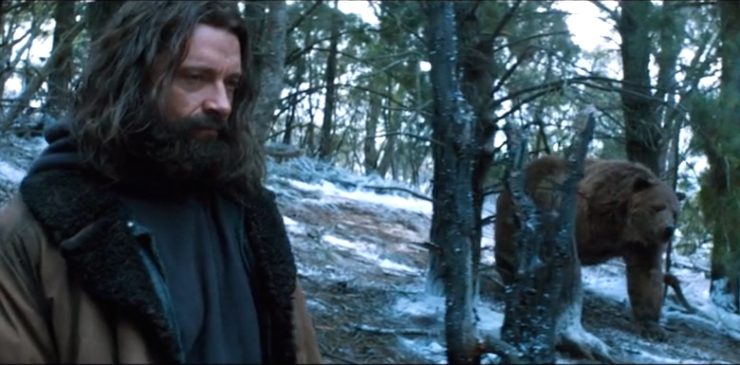
Logan is living in the Canadian woods, having let himself go to seed. He dreams of the day of the Nagasaki bombing toward the end of World War II, where he was a prisoner of the Japanese. He survived in a bunker, having saved the life of the one soldier who took care to release the prisoners before the bomb dropped. (How Logan remembered any of this when he doesn’t remember anything prior to the 1980s or so after being shot in the head in X-Men Origins: Wolverine is left as an exercise for the viewer.)
He also dreams of Jean Grey, where we learn that he has given up being a hero—given up living, truly—over guilt at being forced to kill her at Alcatraz.
After he awakens, he finds a camp that has been overrun by a bear, with several people killed. He tracks the bear and finds that it has a poison arrow in its back. Logan puts the bear out of its misery then uses his enhanced senses to track the arrow to its user, who’s in a bar boasting about the bear he shot. However, the poison arrow he used is illegal, and the poison acted slow, making the bear crazy enough to go and kill five people. Logan stabs the hunter with the arrow in question, and then gets into a bar fight—aided by a Japanese woman wielding a katana.
The woman, who is named Yukio, has been looking for Logan for a year. Her employer is Ichiro Yashida, the head of the tech giant Yashida Industries—and also the soldier Logan rescued the day of the Nagasaki bombing. Yashida is dying, and wishes to say his goodbyes to Logan in person. Logan is reluctant to fly to Japan, but agrees to do so. Yukio is also a mutant, with the ability to see someone’s death.
They arrive at the Yashida estate, a sprawling complex outside Tokyo, where Yashida is plugged into a variety of esoteric medical devices, and is under the care of a blonde oncologist named Dr. Green. Logan meets Yashida’s son Shingen and grand-daughter Mariko. Yukio was an orphan who was taken in by the Yashidas after her parents died as a companion for Mariko when they were both children.
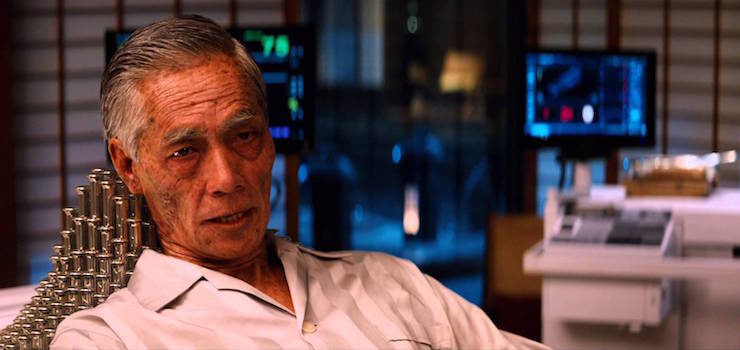
After Logan is given a shave, haircut, and bath (by two very stern-looking women wielding scrub brushes and brooms), he sees Yashida. To Logan’s surprise, he doesn’t just wish to pay final respects; he says he has a way to transfer Logan’s healing gifts to another person, er, somehow. He wants to keep living, and he knows that Logan feels the weight of immortality and wishes to die. Logan is a bit gobsmacked by this, and walks away—just in time to see Mariko consider hurling herself over a ledge shortly after being smacked by her father. Logan saves her.
That night, Logan dreams of Grey and also of Dr. Green breathing poison into his face. When he wakes up, he’s informed that Yashida has died.
Logan attends the funeral with Yukio. He tells Shingen that his father was a good man, and Shingen says that his father said the same of Logan, and also makes it clear that he should go the hell home after the funeral.
Watching over the funeral from the rooftops is Kenuichio Harada, Mariko’s ex-boyfriend and someone she still loves.
Logan notices that two of the monks have yakuza tattoos and once Logan makes them, they prematurely enact their plan to kidnap Mariko. Chaos ensues, and Yukio, Harada, and Logan try to rescue Mariko on a chase that leads through downtown Tokyo. Eventually, Logan helps Mariko escape her captors, and they board a bullet train south. Logan was shot and stabbed several times, and to his annoyance, he’s not healing properly.
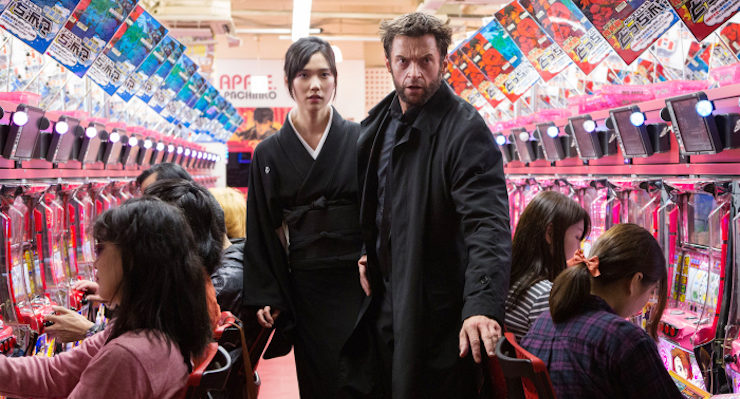
Several yakuza board the train and go after Mariko, but Logan is able to stop them after a fight that includes a lot of being on the roof of a 300MPH train. Sure.
After the attack, Logan insists they get off the train and they book a room in a love hotel in the crummy part of town. (They wind up in the Mission to Mars room.) Logan stands watch over Mariko and then collapses from blood loss. He’s cared for by the hotel manager’s son, who’s a veterinary student, who at least gets the bullets out. (Logan’s never had to worry about that kind of thing before.) He’s concerned at his lack of healing power.
Mariko reveals that the reason why she tried to kill herself—and why Shingen hit her, for that matter—is because before he died, Yashida revealed that he was leaving his entire financial empire to her rather than his son. Yashida had been fending off advances by the yakuza onto his business for some times, which is probably why they’re after her now.
They continue to Nagasaki, the village where the POW camp used to be during World War II. Logan remembers Yashida giving him the family katana—the same one Yukio brought to Canada. However, Logan returned it, then, asking young Yashida to hold it for him.
Green, who’s really a mutant called Viper, is working with Harada and trying to locate Mariko and Logan. It’s not clear who they’re working for just yet, as Harada fought against the yakuza who took Mariko at the funeral.
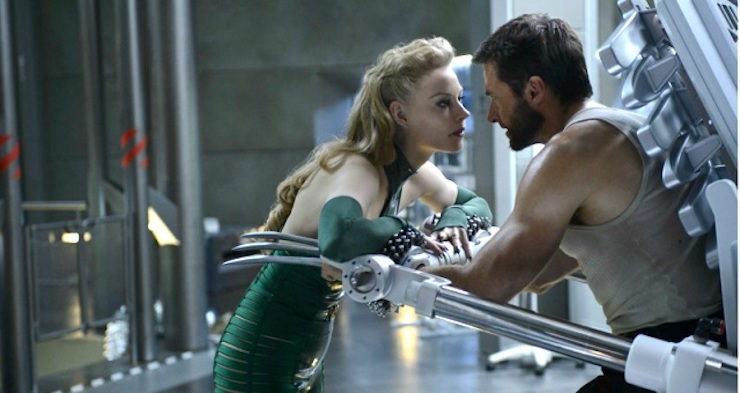
Logan and Mariko fall into bed together. The next morning, Mariko is kidnapped by yakuza, and Logan is unable to stop them, but he does manage to keep one kidnapper from escaping. A very brief interrogation reveals that they were hired by Mariko’s fiancé. (A politician in bed with the yakuza! Amazing!) Yukio arrives, despite having been warned by Mariko to stay away, because she has seen Logan die.
They question Mariko’s fiancé, who reveals that he and Shingen plotted to have her killed at the funeral so Shingen would get the company. (Mariko wouldn’t go through with the marriage if she owned the tech giant.) We learn from Shingen that Yashida bled the company dry trying to prolong his life; Shingen shielded the general public from this knowledge that Yashida was almost bankrupt, and he thinks he deserves more than to be shut out of the will.
But before he can kill Mariko, Viper shows up along with Harada and his pet ninjas to take Mariko. Logan and Yukio arrive too late, but Viper left a note saying where to find them. Using the fancy-shmancy medical scanner, Logan realizes there’s a robotic parasite on his heart, which is probably what’s suppressed his healing ability. He cuts himself open and rips it out.
While he’s doing that, Shingen tries to kill him, but Yukio holds him off until Logan can get the parasite out and restore his powers. Once he does so, he fights Shingen to the death. (He’s willing to let him live with being a person who would kill his own daughter, but he refuses to stop fighting, so Logan kills him.)

They travel to a stronghold in the village where Yashida was born. Harada is there, along with his gang of ninjas, Viper, and a giant suit of silver armor—which, it turns out, is keeping Yashida alive. Viper had planned to transfer Logan’s healing ability to Yashida, and now she can finally do it, having used Mariko to lure him there.
The Silver Samurai fights Logan, cutting off his claws with an adamantium sword that also glows hot. He then drills into the bone claws beneath them to siphon off Logan’s healing power (I guess via bone marrow?). Yukio kills Viper, and the Samurai kills Harada, who is appalled at what Yashida has turned himself into. (Little late, there, bucko.)
Mariko grabs two of Logan’s sliced-off adamantium claws and stabs Yashida in the head and neck. When he tries to appeal to her sense of family duty, Mariko simply says that she already buried her grandfather. Logan then says “sayonara” and throws him out a window.
With Shingen dead, Mariko says that she’s now alone, with Yukio her only family. (Her mother, whom we saw at the house and at the funeral early on, has apparently been totally forgotten about.) However, Yukio goes off with Logan, who has come to realize that he’s a soldier, just like Yukio said he was back in Canada when she talked him into going to Japan. They fly off to have adventures.
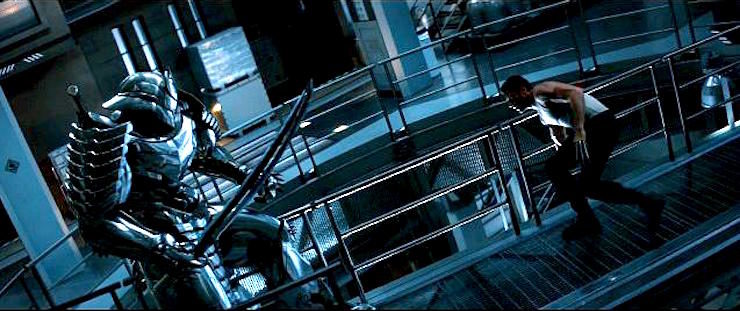
Two years later, Logan’s going through an airport, only to have everyone around him frozen, and he’s confronted by Charles Xavier, whom he thought was dead, and Magneto. There’s a dire threat to all mutants, that they will all have to deal with in the next movie in the sequence.
“Sayonara”
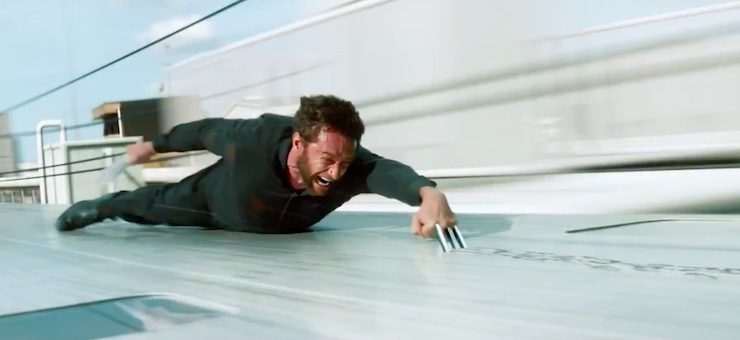
The original miniseries that this movie takes its primary inspiration from, as well as the two-part followup in the main team book, are classics. I actually like the followup story more, as the miniseries is a little too obviously constructed to play to Frank Miller’s ninja fetish. Plus a lot of the worst clichés that have come to dog the Wolverine character over the last thirty-five years or so come directly from that first miniseries (including the tiresome macho catch phrase about how he’s the best there is at what he does, but what he does isn’t very nice). Far too many Wolverine stories have gone back to that well, most of them pale imitations of the source material.
This movie is no exception. Screenwriters Mark Bomback and Scott Frank have taken a fairly simple plot—long-lost father returns to family, turns them into crimelords, our hero must help the woman he loves regain the family honor—and convolute the hell out of it. We’ve got yakuza, we’ve got ninjas, we’ve got family drama, we’ve got a spectacularly unconvincing fight atop a bullet train (mind you, I have no problem with anything Logan did on top of the train, it’s that any of the yakuza thugs lasted more than a second up there), we’ve got different factions of different people wanting people dead, maybe, except maybe just kidnapped or what the hell? If Yashida’s intent was to live, why did he even bother with a will and faking his death? Was he giving it all to Mariko because he intended to use her as a figurehead and was he just a sexist asshole who didn’t realize his grand-daughter was awesome? (Mind you, that would be perfectly possible, but aside from one cryptic bit of dialogue from Viper, it’s totally unclear.)
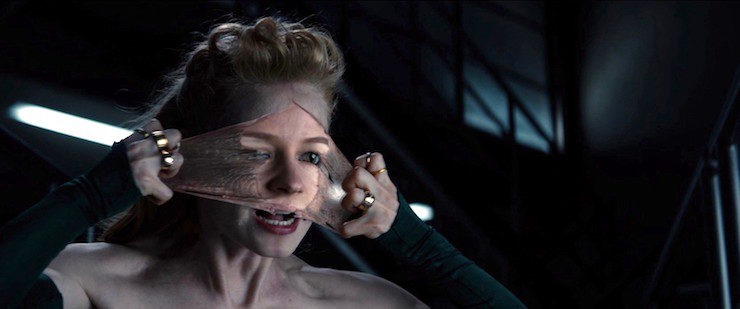
Speaking of Viper, what the heck is up with her? Apparently, nobody explained the difference between Viper and Poison Ivy to the filmmakers, and also they thought it would be cool for her to shed her skin for, um, reasons? Seriously, why does she shed her skin? And how does it help her heal from an arrow to the chest or a fall from a great height, exactly? Also, shedding her skin removes her hair but somehow keeps her eyebrows…
I have no problem with changes to the source material when adapting to another medium, but it helps immensely if those changes serve a purpose. In the comics, Viper and Silver Samurai were long established as partners, and the latter was part of Clan Yashida, and so was involved in the family doings. Viper doesn’t have that connection, so instead she’s this weird snakey thing who spits poison that sometimes kills and sometimes doesn’t. Seriously, why doesn’t her breathing poison into Shignen’s face kill him? (It’s so Shingen can fight Yukio and Logan, because we don’t have enough action pieces in this movie full of yakuza thugs and ninjas, apparently.)
Harada doesn’t fare much better, as first he’s on Mariko’s side, then he appears to be working against her and Logan on Yashida’s behalf, and then he betrays Yashida, and then he dies and I still haven’t figured out what, exactly, his motivations have been. And unlike Svetlana Khodchenkova, I know that Will Yun Lee can act—I’ve seen him do it lots of places, including in two much worse movies than this in this very rewatch (not to mention assorted excellent TV roles he’s had)—but he’s got nothing to work with here.
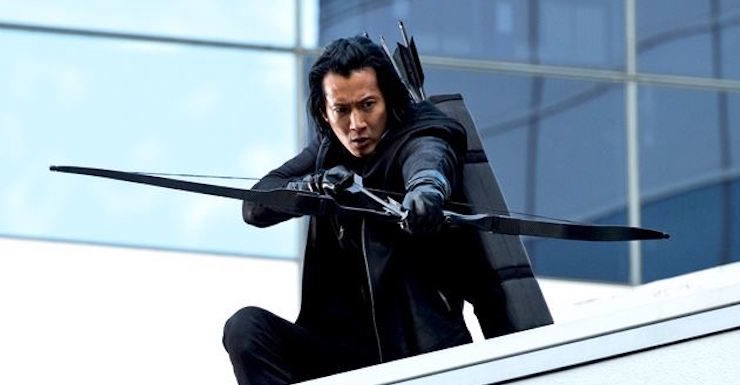
Another change to the source material that should work but doesn’t is Yukio’s death-premonition powers. It fits nicely with the themes of death and life and stuff, but it never quite comes together the way it should. At least Yukio has other things to do involving kicking lots of ass (though why they turned her into a Westerner’s idea of an anime character rather than the dark-haired punk she was in the various X-comics is beyond me).
And then there’s Logan lecturing Mariko on not going to a place where people might find them, and they go to the village where the POW camp is where Logan rescued Yashida during the war, which is the first bloody place anybody would look, especially since they know they were on a train headed south. (As Shingen himself says, Japan is a skinny island with trains that only run north-south.)
The hilarious part of all this is that I actually really enjoy The Wolverine. It’s fun to watch. More than any other X-movie, this is the one in which Jackman feels most like the character I’ve been reading in the comics since I was a child. His prior performances ranged from excellent to awful (the latter mostly being in Origins, in which he seemed to be going through the movie in a constant state of constipation), but here, he’s finally firing on all thrusters, perfectly nailing the fierceness, the compassion, the honor, the danger, all mixed in with some serious guilt over having to stab the woman he loves in the last movie. And many of the performances are superb, particularly Tao Okamoto and Rila Fukushima. (The latter will go on to do equally superbly on Arrow as Katana, while the former will be in Batman v. Superman as Mercy Graves.)
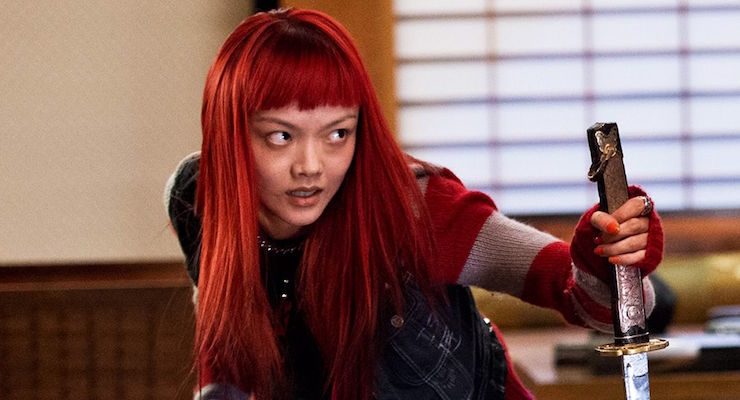
As long as you don’t think about it, and just enjoy the location shooting in Japan and the nifty action scenes with ninjas and stuff, and don’t mind a climax that’s mostly just the hero fighting a CGI creature (a mode we’ll be coming back to, um, a lot as we move forward in this here rewatch), this is an enjoyable film. Just don’t think about it too much.
Like X-Men Origins: Wolverine, this movie was a financial success, and unlike the previous film, a critical one as well. Mangold was brought back to, not only direct, but also co-write Logan, which we’ll cover next week.
Keith R.A. DeCandido is hard at work on Mermaid Precinct, the latest book in his fantasy police procedure series. In anticipation, you can catch up on the previous books, which have been reissued by eSpec Books: the novels Dragon Precinct, Unicorn Precinct, Goblin Precinct, and Gryphon Precinct (all of which have bonus short stories in these new editions), and the short-story collection Tales from Dragon Precinct. Ordering information can be found here.










